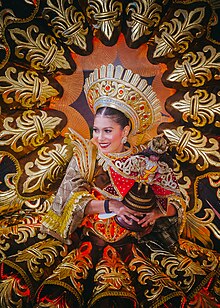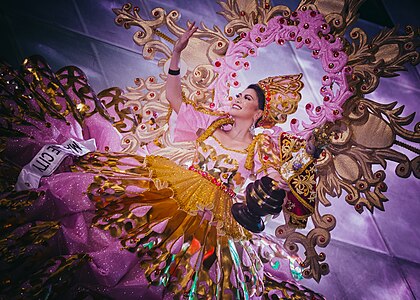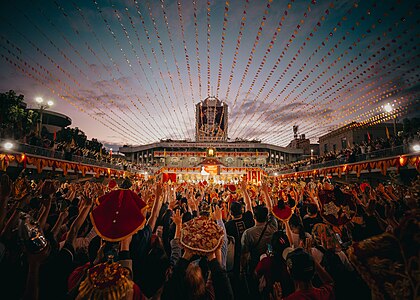Sinulog
| Sinulog Festival | |
|---|---|
 Carrying the Holy Child Jesus, locally known as Santo Niño, this Festival Queen praises the Holy Child with her contingent. | |
| Official name | Sinulog Festival |
| Also called | Sinulog |
| Observed by | Cebu City |
| Type | Religious / Cultural |
| Date | Third Sunday in January |
| 2024 date | January 21 |
| 2025 date | January 19 |
| 2026 date | January 18 |
| 2027 date | January 17 |
| Frequency | Annual |
| First time | January 20, 1980 |


The Sinulog Festival (as known as Sinug and Sulog) is an annual cultural and religious festival held on the third Sunday of January in Cebu, with the center of the activities being in Cebu City, and is the centre of the Santo Niño Christian celebrations in the Philippines.[1]
The festival is widely regarded as one of the largest cultural and religious festivals in the Philippines, with every celebration of the festival routinely attracting between 1 million and 1.5 million people each year.[2] Aside from the religious aspect of the festival, Sinulog is also famous for its street parties, usually happening the night before and the night of the main festival.[3] The festival is sometimes referred to as the 'Grandest Festival in the Philippines' by some participants and locals.[4]
Other places in the Philippines also celebrate their own version of the festival in honor of the Santo Niño, both within Cebu like Carmen, and outside Cebu, including Tondo, Kabankalan, General Santos, Maasin, Cagayan de Oro, Butuan, Pagadian, Balingasag, and Don Carlos, Bukidnon.
Etymology
[edit]This section needs additional citations for verification. (September 2011) |
The word Sinulog comes from the Cebuano adverb sulog, roughly means water current describing the forward-backward dance movements. The dance consists of two steps forward and one step backward, done to the sound of drums. The dance is categorized into Sinulog-base, free-interpretation, and street dancing. Candle vendors at the Basilica continue to perform the traditional version of the dance when lighting a candle for the customer, usually accompanied by songs sang in Cebuano.
Sinulog is the ritual prayer-dance honoring the Señor Santo Niño or the Child Jesus. An image of the Child Jesus is said to be the baptismal gift Ferdinand Magellan gave to Hara Amihan (Humanay) of Zebu (now Cebu) in April 1521. The image, believed to be miraculous, is housed at the Basilica Minore del Santo Niño in downtown Cebu City.
The Sinulog dance moves are often identified to be two steps forward and one step backward as the dancer sways to a distinct rhythm of drums. This movement is made to resemble the current (sulog) of what was known as Cebu's Pahina River.
According to historical accounts, Cebuanos had already performed dances similar to the Sinulog to honor animist idols long before the introduction of Christianity to the Philippines, which arrived in Cebu with the arrival of Ferdinand Magellan who led a Spanish expedition on April 7, 1521. The original image of Santo Niño was reportedly left by the Magellan expedition, and was rediscovered when the Spanish returned in 1565 during the expedition led by Miguel López de Legazpi, which played a significant role in the subsequent Spanish colonial period in the Philippines.
The Sinulog is observed as a celebration of the Filipino people's embrace of Christianity, marking a significant moment in the country's religious and cultural history, particularly in Cebu. The first of these conversions happened in 1521 on the island of Cebu, when Indianized-Sanskritized ruler Rajah Humabon and his queen Amihan (Humamay) were baptized along with their subjects, becoming Carlos and Juana of Cebu.[5][irrelevant citation]
History
[edit]
On March 16, 1521, Ferdinand Magellan arrived and planted the cross on the shores of Cebu, claiming the territory for Spain. He presented the image of the Child Jesus to the Rajah Humabon. Hara Humamay (or Amihan in some versions) was later named Queen Juana after Juana, mother of Charles I of Spain along with the rulers of the island and some 800 natives were also converted to the Christian faith.
Some Sinulog dances interpret the historical events surrounding the arrival of the Spaniards and the presentation of the Santo Niño to Queen Juana, though various performances may emphasize different aspects of the festival's history and significance. A popular theme among Sinulog dances is Queen Juana holding the Santo Niño in her arms and using it to bless her people who were often afflicted with sickness believed to be caused by demons and other evil spirits.
The Sinulog dance steps are believed to originate from Rajah Humabon's adviser, Baladhay.[dubious – discuss] It was during Humabon's grief when Baladhay fell sick. Humabon ordered his native tribe to bring Baladhay into a room where the Santo Niño was enthroned, along with the other pagan gods of the native Cebuanos. After a few days passed, Baladhay was heard shouting and was found dancing with utmost alertness. Baladhay was questioned as to why he was awake and shouting. Pointing to the image of the Santo Niño, Baladhay explained that he had found on top of him a small child trying to wake him and tickling him with the midrib of the coconut. Greatly astonished, he scared the child away by shouting. The little child got up and started making fun of Baladhay. In turn, Baladhay danced with the little child and explained that he was dancing the movements of the river. To this day, the two-steps forward, one-step backward movement is still used by Santo Niño devotees who believe that it was the Santo Niño's choice to have Baladhay dance.
Arrival of López de Legazpi
[edit]The expedition led by Miguel Lopez de Legazpi bombarded the native settlement when they arrived on April 28, 1565. In one of the burning huts, one of Legazpi's men, Juan Camus, discovered the image of the Santo Niño inside a wooden box beside other idols. When Legazpi arrived, he found that the natives performed dances, which were later associated with the honoring of the Santo Niño. This moment, known as the Kaplag, would be spun off into a summer time festival in the 2020s.
The Augustinian friars that accompanied López de Legazpi in his expedition built a church on the site where it was found. The church was called San Agustin Church, later renamed to Basilica Minore del Santo Niño.
Letter to the King of Spain
[edit]After Juan Camus found the Santo Niño in the burning village, López de Legazpi was said to have included the incident in his report, entitled "Relation of Voyage to the Philippine Islands":
- "Your Excellency should know that on that day when we entered this village (Cebu City), one of the soldiers went into a large and well-built house of an indio where he found an image of the Child Jesus (whose Most Holy Name I pray may be universally worshipped). This was kept in its cradle, all gilded, just as if it were brought from Spain: and only the little cross, which is generally placed upon the globe in his hands, was lacking. The image was well kept in that house, and many flowers were found before it, and no one knows for what object or purpose. The soldier bowed down before it with all reverence and wonder, and brought the image to the place where the other soldiers were. I pray to the Holy Name of his image, which we found here, to help us and to grant us victory, in order that these lost people who are ignorant of the precious and rich treasure, which was in their possession, may come to knowledge to him."
Today
[edit]
Since the 16th century, there has been great devotion to the Santo Niño in Philippine popular piety, particularly in the Visayas. Pilgrims from different parts of Cebu and the rest of the Philippines make their yearly journey to the church to take part in the procession and festival. Starting in 1980, the Cebu City government organized the Sinulog Festival and eventually gave incentives also to tribal dance groups. The first Sinulog parade was held on January 20, 1980,[6] organized by Dávid Odilao, then Regional Director of the Ministry of Sports, and Youth Development, with the Sinulog conceptualized to be a "true Cebuano festival",[7] comparable to the Dinagyang of Iloilo and the Ati-atihan of Aklan, both of which also celebrate the feast of Sto. Niño. The parade was composed of students dressed in Knitted Filipiniana costumes, dancing the Sinulog to the beating of drums.
The idea caught and thus, under the direction of then-Cebu City Mayor Florentino Solon with the help of several influential Cebuanos, Odilao turned over the Sinulog project to the Cebu City Historical Committee under Kagawad Jesus Garcia. It was the task of the committee to conceptualize the Sinulog festival and make it into a yearly event from then on.
In 1981, the concept of the Sinulog Parade was actualized involving not just Cebu but also representatives from other provinces in the Philippines. Marking its difference from another popular Visayan festival, the Ati-Atihan, the Sinulog focuses on both the ritual aspects and the historical context of the dance, which symbolizes the Philippines' embrace of Christianity.
In the 2000s and the early 2010s, law and order during the Sinulog celebration was an issue for years. Large street parties were celebrated throughout the city, notably along General Maxilom Avenue (also known as Mango Avenue) and the Baseline area along Juana Osmeña Street. Some rowdy party-goers have run into trouble, and many have been found sleeping along the city's streets due to intoxication. In 2016, street parties along the Sinulog carousel route were banned in an effort to control most of the disturbances caused by these street parties.[8]
The Devotee City, a temporary accommodation place consisting of reused shipping containers, has also been launched since 1996 to accommodate devotees from far-flung areas who do not have any accommodation within Cebu City or other nearby areas. It is usually located in the open space surrounding the Compania Maritima building, and is only a few meters away from the Magellan's Cross and the Basilica del Santo Niño.[9][10][11][12]
The festival was cancelled in 2021 because of the COVID-19 pandemic,[13] and again in 2022 due to the devastation caused by Typhoon Rai to Cebu.[14] Since 2023, the grand parade has been moved to the South Road Properties (SRP) instead of the Cebu City Sports Center (CCSC), its long time-home, by Cebu's current mayor and the overall chairman of the Sinulog Foundation Incorporated (SFI), Michael Rama, largely against the interest and welfare of the Cebuanos. The Sinulog sa Kabataan sa Dakbayan and the Sinulog sa Lalawigan, which are qualifying events for the main Sinulog event, however, still remain at the CCSC.
Two contingents have joined from other festivals in one national festival from MassKara Festival in Bacolod City and one international from South Korea.
The festival, for the first time, had two major parades in 2024. The "Sinulog sa Lalawigan", which was originally the preliminary competition "Sinulog sa Kabataan sa Lalawigan", was transformed into a Sinulog parade for provincial contingents since they could not, once again, dance in SRP. The Sinulog sa Lalawigan was held in the CCSC, the old venue of Sinulog. The other contingents from Cebu City and out-of-town danced in the Sinulog parade on the 3rd Sunday of January in SRP. The backlash from the move from 2023 proved all too much that in August of 2024, Cebu City Acting Mayor Raymond Alvin Garcia, officially announced the return to the CCSC for the Sinulog festivities in 2025 in time for the 2025 Jubilee Year and the festival's Sapphire Jubilee.
Cebuanos also celebrate the Sinulog worldwide in Filipino communities in other countries such as the "Winter Sinulog" (which is celebrated in January in cold countries) and "Summer Sinulog" (which is also celebrated in August) in Philadelphia from the United States. Sinulog has also been performed in international competitions in South Korea and the Philippine Independence Day Parade in New York City.
Qualifying Week
[edit]Two traditional qualifying events at the Cebu City Sports Complex mark the week before the Sinulog festival day.
The city qualifying event, the Sinulog sa Kabataan sa Dakbayan (Sinulog for the Youth of the City), is the first qualifying event and is a competition exclusive to schools and community troupes from Cebu City. The second one, the Sinulog sa Lalawigan (Sinulog of the Province), is organized by the Cebu provincial government which is participated by school and cultural groups from all over Cebu province.
The champions of the two qualifying events advance to the main Sinulog grand parade and a number of competitors from both also are granted automatic bids for the same for their performance.
- The activities during at Sinulog
-
Sinulog Festival Queen
-
Street Procession
-
Fluvial Procession
-
Street Dancing
-
Novena Mass at Basilica del Santo Niño
Grand Parade winners
[edit]Logo
[edit]
The Cebu City Historical Committee, which was responsible for the conceptualization of the Sinulog as a provincial event, decided to adopt a logo to identify it as an institutionalized yearly event. They turned to the coat of arms of the Santo Niño which consisted of a two-headed hawk that was the mark of the ruling House of Habsburg in Europe. The emblem represented the twin purpose of the Habsburg dynasty as "Champion of Catholicism and Defender of the Faith." At the time when Spain sent expeditions to the Philippines, they were under the Habsburg dynasty. The committee viewed using the image of the Santo Niño as part of the symbol as sacrilege.[15]
The Sinulog committee then incorporated the two-headed eagle to a native warrior's shield. The native shield is supposed to symbolize the Philippine's resistance to colonization while the Santo Niño's coat of arms printed on its face represents the country's acceptance of Christianity.[citation needed]
See also
[edit]- Sinulog idol
- List of Sinulog Festival Winners
- Basilica del Santo Niño
- Santo Niño
- Dinagyang
- Ati-Atihan Festival
References
[edit]- ^ "Sinulog Festival in Cebu City: A Feast for the Senses". Suroy.ph.
- ^ Gavilan, Jodesz (January 16, 2016). "FAST FACTS: Things to know about Sinulog". Rappler. Retrieved March 10, 2017.
- ^ "Top Sinulog Parties! – Everything Cebu". www.everythingcebu.com.
- ^ "Cebu's Sinulog: The Grandest Festival in the Philippines | Sugbo.ph". January 6, 2019. Retrieved April 21, 2022.
- ^ "The Cebu Skin Dispensary Cebu, Cebu". Leprosy Review. 2 (3). 1931. doi:10.5935/0305-7518.19310032. ISSN 0305-7518.
- ^ Bongcac, Doris C. (January 14, 2014). "Revive event's roots, tradition, Sinulog father says". Cebu Daily News. Retrieved May 8, 2024.
- ^ Sitchon, John; Sabalo, Wenilyn (January 18, 2024). "The 'Father of Sinulog' and the making of Cebu's biggest festival". Rappler. Retrieved January 21, 2024.
- ^ "No more permits for wild parties on Sinulog route". Cebu Daily News. January 3, 2016. Retrieved January 21, 2024.
- ^ "All systems go for Sinulog 2018". Manila Bulletin News. January 14, 2018. Retrieved June 2, 2019.
- ^ "Devotee City opens today | The Freeman". philstar.com. Retrieved June 2, 2019.
- ^ "City Hall clears Compania Maritima lot for Devotee City". cebudailynews.inquirer.net. January 5, 2016. Retrieved June 2, 2019.
- ^ Leyson, O.; Odessa, MBG (January 17, 2019). "Devotee City to open to out-of-town visitors". The Freeman. Retrieved June 2, 2019.
- ^ Santos, Jamil (January 7, 2021). "All Sinulog Festival 2021 physical activities, shows in Cebu City cancelled - Vice Mayor". GMA News. Retrieved January 30, 2024.
- ^ Magsumbol, Caecent No-ot (January 6, 2022). "All Sinulog contests cancelled". Philstar.com. Retrieved January 30, 2024.
- ^ Herrera, Christine (December 31, 2014). "'Bypassed' Cebu to hold grand Sinulog". The Standard. Retrieved March 20, 2016.






